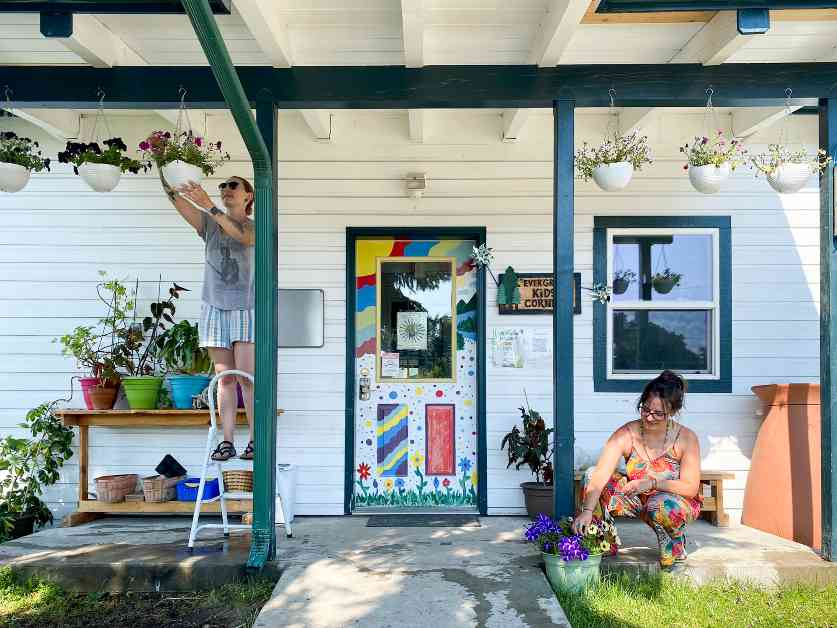Revitalizing Communities with Child Care Services in Old School Buildings
In Missoula, Montana, the Cold Springs Elementary School building stands as a beacon of hope for the community. Once abandoned and neglected, this historic structure now houses a network of child care centers that are breathing new life into the old walls. The Missoula Child Care Advantage (MCCA) initiative has transformed this former school into a hub of learning and growth for young children, offering a solution to the area’s severe shortage of affordable child care.
The Transition from Neglect to Nurturing
From the crumbling exterior to the dated interior, Cold Springs Elementary was a relic of the past until the spring of this year when five independent child care centers opened their doors within its walls. With plans for a sixth center to join in September, the building is now bustling with the laughter and energy of up to 90 children, ranging from infants to preschoolers. The revival of these old school buildings as child care centers is a testament to the creativity and resourcefulness of the Missoula community in addressing a pressing need.
A Nationwide Child Care Crisis
Missoula County’s struggle with affordable child care is not unique. Across the country, parents are facing a child care crisis, with more than half of American children under the age of 5 living in areas with a severe shortage of licensed child care slots. In Montana, the gap between demand and availability is particularly stark, with only 44% of the total demand for child care slots being met. This shortage is even more acute for infants, with only 32% of demand being fulfilled.
For parents like Adam Rasmussen and Meredith Repke, the opening of the MCCA at Cold Springs was a lifeline. After struggling to find child care for their daughter Hope, they were overjoyed to secure a spot at one of the new centers. The convenience of having quality child care just a short distance away allowed them to resume their lives in Missoula, highlighting the profound impact that accessible child care can have on families.
A New Approach to Child Care Infrastructure
The success of the MCCA at Cold Springs is not just a win for Missoula; it serves as a model for other communities grappling with similar child care challenges. By repurposing old school buildings and other underutilized public spaces for child care, communities can address the critical need for affordable and accessible child care services. These innovative solutions not only benefit families but also breathe new life into neglected buildings, creating vibrant centers of learning and growth for young children.
Subheadings:
The Impact of Community Collaboration
Innovative Solutions for Sustainable Child Care
Challenges and Opportunities for Child Care Providers
The Impact of Community Collaboration
The MCCA initiative at Cold Springs is a testament to the power of community collaboration in solving complex social issues. Grace Decker, who spearheaded the formation of the network, brought together a diverse group of stakeholders from child care providers to school district officials to local businesses. This collaborative approach allowed for creative solutions to emerge, such as the membership model that enables businesses to support child care services while prioritizing their employees’ access to care.
Innovative Solutions for Sustainable Child Care
The MCCA’s unique approach to child care infrastructure not only addresses the immediate need for more child care slots but also lays the foundation for sustainable and high-quality child care services. By leveraging unused public buildings like Cold Springs, the network is able to provide affordable rent to child care providers, enabling them to focus on delivering excellent care rather than worrying about costly facility maintenance. This innovative model has drawn interest from other communities across Montana and beyond, eager to replicate Missoula’s success.
Challenges and Opportunities for Child Care Providers
While the MCCA at Cold Springs has been a resounding success, it has not been without its challenges. Co-located child care providers face unique obstacles, such as navigating licensing guidelines that require strict separation between programs. This can be confusing for children and providers alike, highlighting the need for flexible and adaptable regulations that support collaborative child care models. Despite these challenges, the Cold Springs initiative has opened up new opportunities for child care providers to come together, share resources, and build a strong sense of community within the walls of the old school building.
Conclusion:
The revitalization of old school buildings as child care centers in Missoula is a shining example of how communities can come together to address pressing social issues. By repurposing underutilized public spaces, like Cold Springs Elementary, for child care services, communities can provide much-needed support for families while breathing new life into neglected buildings. The success of the MCCA initiative serves as a beacon of hope for other communities facing similar child care challenges, demonstrating the power of collaboration, innovation, and community-driven solutions in creating a brighter future for all.

